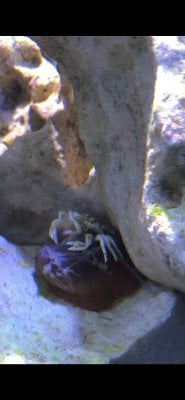Crabs McJones
I'm so shi-nay
View Badges

Excellence Award
Reef Tank 365
Article Contributor
Moderator Emeritus
Hospitality Award
Reef Tank 365 Boss
Wisco Reefers
My Tank Thread
Anemones and Why You Should Wait
When is the proper time to add an anemone to your tank? Right away? 1 month? 4 months? WHAT!? A YEAR YOU SAY!?
That is correct. In most instances it is better to wait 8 months to a year before adding an anemone to your tank. And here is why:
A tank is first started with rock, sand, and saltwater. That tank needs to cycle before adding any livestock to it. This we all know. But what you may not know is even after your cycle has completed your tank is going to go through many different changes. Parameters are going to raise and decrease (some even dramatically). You’re going to see algae come and go, and find all kinds of new and exciting hitchhikers. Not only that, but if you are a new reefer and are just getting your toes salty, there are many mistakes you’re going to make. It’s just the nature of the hobby. Don’t feel bad as there are mistakes that even expert reefers make. It’s our nature.
With that being said, anemones are extremely sensitive and generally cannot handle the parameter swings of new and maturing tanks. A new or maturing reefer may add one to the system and find that the anemone looks good to begin with, but as time progresses it starts looking bad; inflating and deflating, closing up, losing its tentacles, losing its color. You may also notice that the anemone won’t pick a spot and keeps releasing its foot and floating around the tank. This could potentially be due to a number of things:
1. Parameter swings
2. Parameter out of acceptable range
3. Insufficient lighting
4. Anemone isn’t getting along with neighboring coral
5. Handling (when you want it to attach in a certain spot, but it doesn’t and you keep moving it back to that spot)
6. Starvation (could be correlated with insufficient lighting depended on the circumstances)
With the exception to insufficient lighting, all the other potentials listed above are common of new and maturing tanks.
When an anemone dies it releases toxins into the tank that could potentially wipe out all your other inhabitants and coral. Avoiding that by waiting is the best thing you can do for your tank and inhabitants.
How do I know if my tank has matured? Aside from the time, other indicators that your reef is mature enough would be water quality stability. No swings or shifts in parameters after several weeks. Also you haven't observed any random outbreaks of algae that you cannot explain.
I hope that this info is found useful to those thinking about an anemone.
Remember that in this hobby nothing good happens quickly, only bad things. Take it slow, and let your tank mature before adding your anemone and your inhabitants will thank you.




















